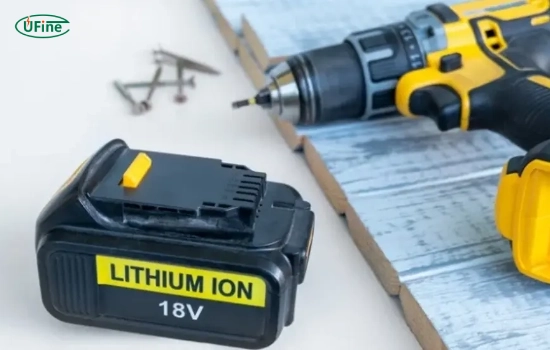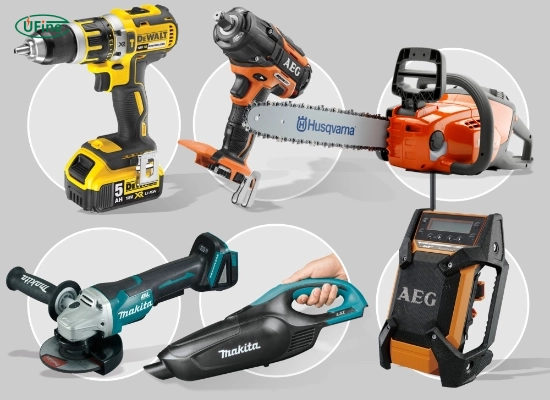Power tool batteries play a pivotal role in our daily lives, powering many essential tools. This article aims to provide comprehensive insights into the various types of power tool batteries, the critical factors to consider when selecting them, and essential maintenance tips for ensuring optimal performance.
Part 1. Types of power tool batteries
Lithium-ion Batteries (Li-ion)
Lithium-ion batteries have become the standard in power tools due to their high energy density and lightweight nature. They offer longer run times, faster charging capabilities, and have no memory effect, allowing partial charging without reducing the battery’s overall lifespan. Li-ion batteries are versatile and compatible with various power tools, making them popular among professionals and DIY enthusiasts. They are commonly used in cordless drills, impact drivers, and circular saws.
Nickel-cadmium Batteries (NiCd)
NiCd batteries were once prevalent but have largely been replaced by Li-ion batteries due to their lower energy density and the presence of cadmium, an environmentally hazardous material. They are known for their durability and ability to withstand high temperatures. However, they suffer from the memory effect, which can reduce overall capacity if not fully discharged before recharging. NiCd batteries are typically found in older models of power tools such as cordless screwdrivers and some types of power drills.
Nickel-metal Hydride Batteries (NiMH)
NiMH batteries are an improvement over NiCd batteries, offering a higher energy density and being more environmentally friendly as they do not contain toxic cadmium. They have less memory effect than NiCd batteries but still exhibit some, requiring occasional total discharges to maintain performance. While less common in power tools today, they still find use in some models. These batteries are generally used in mid-range cordless power tools such as electric shavers, flashlights, and some types of garden tools like hedge trimmers.
Lead-acid Batteries
These batteries are commonly found in more extensive tools or stationary equipment due to their weight and size. They are inexpensive and reliable but heavy and have a lower energy density than newer technologies. Lead-acid batteries require regular maintenance and are less suitable for portable power tools due to their weight and size. They are most commonly used in larger equipment like floor scrubbers, backup power supplies, and some types of ride-on lawn mowers.
Intelligent Batteries and Advanced Technologies
Modern power tool batteries often have intelligent features such as battery management systems (BMS) that optimize performance, prevent overcharging, and offer charger compatibility. Additionally, advancements in materials and designs continuously improve battery efficiency, durability, and overall lifespan. Intelligent batteries are used in high-end power tools like smart drills, advanced saws, and professional-grade nail guns.
Part 2. Importance of a reliable power tool battery
Enhances Productivity
A dependable power tool battery ensures uninterrupted workflow. Whether it’s a construction site, woodworking shop, or any other professional setting, a consistent power supply facilitates continuous work without frequent interruptions for recharging or switching batteries.
Cost
Investing in a high-quality power tool battery might seem like a more significant upfront cost. Still, it pays off in the long run. Reliable batteries tend to have longer lifespans, reducing the frequency of replacements and minimizing overall expenses.
Performance
A good battery significantly impacts the performance of power tools. It influences the tool’s speed, torque, and overall efficiency. Quality batteries maintain consistent power output, allowing tools to operate at optimal levels, thus ensuring precise and efficient work.
Safety Assurance
Unstable or unreliable batteries pose safety risks. A dependable power tool battery reduces the likelihood of malfunctions, overheating, or sudden power failures, ensuring a safer work environment for professionals.
Durability and Longevity
Premium batteries are designed for durability. They withstand frequent recharges and discharges, maintain their capacity over time, and are often equipped with safety features that protect against overcharging or excessive discharge, thus extending their lifespan.
Customer Satisfaction
For businesses relying on power tools, delivering consistent and high-quality work is crucial for customer satisfaction. A reliable battery ensures that projects are completed efficiently, meet deadlines, and uphold quality standards.
Adaptability and Compatibility
Reliable batteries often come with compatibility across various tools and models. This adaptability streamlines inventory management, allowing professionals to interchange batteries among different tools, enhancing convenience and efficiency.
Part 3. Power tool battery care tips
1. Charging Practices
- Prevent Overcharging: Unplugging the battery once it reaches a full charge prevents overcharging, which can degrade battery life.
- Regular Use: It’s beneficial to use the battery regularly. If not used for extended periods, aim for a partial charge (around 40-50%) and store in a cool, dry place.
- Compatible Chargers: Always use chargers recommended by the tool manufacturer to prevent damage or overloading.
2. Temperature and Storage
- Temperature Control: Extreme high and low temperatures can adversely affect battery life—store batteries in a cool, dry place, ideally at room temperature.
- Avoid Complete Discharge: Try not to completely discharge the battery before recharging. Partial discharges are better for battery longevity.
3. Preserve Practices
- Cleaning: Keep battery contacts clean and free from dirt or debris to ensure proper connections and charging efficiency.
- Avoid Physical Damage: Protect batteries from physical damage, including drops or impacts, as this can affect their internal components and performance.
- Usage Guidelines: Follow the manufacturer’s instructions regarding the intended use and charging/discharging cycles for optimal performance.
Long-Term Care
- Replacement Timeline: Batteries have a lifespan. Monitor performance and replace them when they significantly lose capacity or fail to hold a charge.
Usage Tips
- Avoid Extreme Loads: Heavy loads or excessive usage can strain the battery. Use the appropriate tool for the task at hand to prevent unnecessary strain on the battery.
- Cooling Period: After heavy use, allow the battery to cool down before recharging it to maintain efficiency.
Part 4. FAQs
-
How many years do power tool batteries last?
The lifespan of power tool batteries varies based on usage, charging habits, and maintenance. Typically, they last around 2-5 years or 500-1000 charge cycles before experiencing significant capacity loss. -
What kind of battery is in a cordless drill?
Cordless drills often use rechargeable batteries, commonly lithium-ion (Li-ion) batteries, due to their high energy density, providing longer runtime and better performance than other battery types. -
What power tool batteries last the longest?
Among various power tool batteries, lithium-ion (Li-ion) batteries tend to have a longer lifespan, better performance, and higher energy density compared to other types, making them famous for their durability and efficiency. -
What kind of battery is in a power tool?
Power tools can use various types of batteries, such as nickel-cadmium (NiCd), nickel-metal hydride (NiMH), and lithium-ion (Li-ion). The choice depends on factors like power requirements, weight, and runtime needed for the tool. -
Is it OK to store power tool batteries in the garage?
Storing power tool batteries in the garage is generally acceptable if done correctly. Ensure they are kept in a cool, dry place away from extreme temperatures and direct sunlight to maintain their health and performance.
Related Tags:
More Articles

How to Choose the Best Floor Scrubber Battery for Commercial Cleaning?
Selecting the ideal floor scrubber battery ensures a long runtime, rapid charging, and minimal maintenance for efficient commercial cleaning operations.
Battery for Blower vs Battery for Leaf Vacuum: Which One Should You Choose?
Battery for blower vs leaf vacuum—learn the key differences in power, fit, and runtime to choose the right battery for your outdoor tool needs.
How to Choose the Right Battery for Blower?
Choosing the right blower battery? Consider voltage, capacity, chemistry & usage. This guide helps match the best battery for peak performance.
How to Choose the Best Insulated Battery Box for Lithium Batteries?
Choosing the Best Insulated Battery Box for Lithium Batteries? Discover key factors such as size, material, and safety for optimal protection and performance.
7 Critical Elements on a Lithium Battery Shipping Label
What must be on a lithium battery shipping label? Learn 7 key elements to ensure safety, legal compliance, and correct handling across all transport modes.





